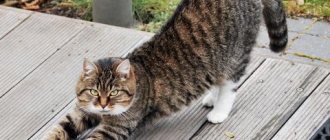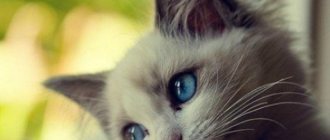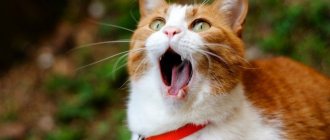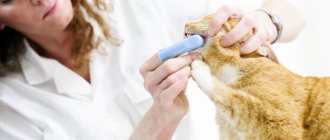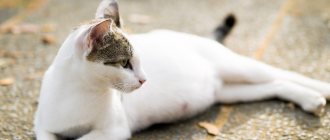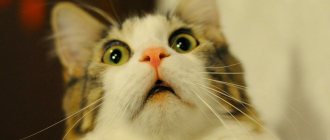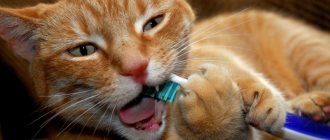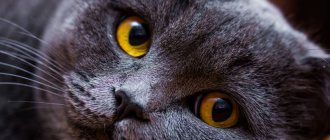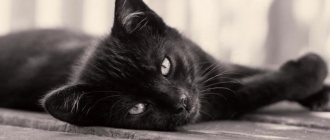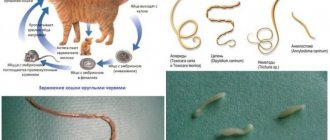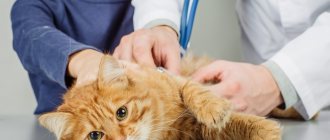Communication tools used by cats
Learning to understand the language of cats is not at all difficult. The most important thing is to know what means your pet uses to communicate and pay attention to these manifestations. The main way to convey information to the owner or another animal is through the voice.
© shutterstock
The sounds made by a cat are very diverse, as is the range of emotions hidden behind them. With the help of its voice, an animal can make it clear both about its absolute peace and about its uncontrollable anger. Other means of furry language include :
- tail;
- eyes;
- gestures and postures (movements of the body, tail, whiskers, paws and their specific position);
- wool.
Each method is discussed in more detail below. Studying the language of cats will bring a lot of amazing discoveries.
What is the cat talking about?
When talking, cats make many different sounds. How should a person understand each of them? Take purring, for example. It has a low pitch, similar to murmur; the sounds seem to roll and are accompanied by a pleasant vibration.
If a cat purrs, it means she is content, happy and calm. Usually, furry beauties make such sounds when they climb into the arms of their beloved owner or find a cozy place where they relax after their “righteous labors.” A wary, tense, preoccupied or hungry cat will never purr.
If an animal growls or, even more so, hisses, this is “translated” from its language as follows: something is very much not to its liking. Such sounds are a manifestation of aggression. The cat is clearly determined to defend his interests, and is extremely determined. This happens when a stranger invades his territory, a dog or another sworn enemy appears “on the horizon.” Or he’s simply stubborn and doesn’t want to fulfill the owner’s demands.
The clicking of teeth in the language of cats is a slightly different sign. Although he doesn’t talk about anything good either. Most likely, the cat is very upset or annoyed about something. Often, a cat chatters its teeth if its hunt is unsuccessful and the tasty mouse “slipped out of its paws.”
© shutterstock
How experience affects a cat's behavior
Cats, under any conditions, strive for a better life and adapt to existing conditions. For example, if a pet lives in a family with a large number of other animals, then he will quickly learn to get the best pieces of food for himself, getting them from other people's bowls, the refrigerator, and even a boiling pan. The ingenuity of cats in this regard has no limits, and the cat will retain the experience gained for the rest of its life. Also, it is this animal that will fight for the owner’s attention, receiving affection from him more than others.
If the cat is the only pet, then it will not be greedy about food, it eats leisurely and even, at times, with some reluctance. Communication with children also affects a cat’s behavior, especially if it was negative. The animal will remember this for the rest of its life and will try to avoid repetitions. A timid cat will run away when it sees a little “tyrant”, and an aggressive one will immediately attack to avoid discouraging. Owners need to be careful and, preferably, anticipate the pet’s possible reaction to the current situation.
Eyes, mustache, ears
A sensitive and observant owner understands his pet, as they say, without words. For example, by the eyes. The owner knows that if the cat looks straight and there is calm in her gaze, it means she is in a positive mood, and her intentions are quite friendly. Sometimes cats do not take their eyes off the object, literally boring into it with them.
In the language of cats, this is a warning of readiness to attack. This is how two competing males look at each other, for example . Eyes into eyes, fur on end, tail like a pipe. The game is “knockout”: whoever gets distracted first is the one who “flies away”.
Dilated pupils in cat language indicate that the animal is frightened and is ready to flee. Or that the animal is in pain and is unsure of something. If a cat sits in front of the door, raising its eyes to the “sky,” this should be understood as a desire to enter.
An animal looking at the floor knows or senses that there is someone behind the door. Half-closed eyes, translated from the language of a cat, mean relaxation and tranquility. Cats with their tongues wide open indicate a burning interest in what is happening around them. The animal makes certain signs with its ears. If they :
- move - the cat is listening to the conversation, she is wary, wants to understand what is happening;
- pressed and pulled back - in the language of a fluffy, this means that he is in a playful state;
- pressed and lowered on the sides - the cat is aggressive or very frightened;
- pressed very tightly (while the cat is spread out on the floor) - a sign of complete obedience.
© shutterstock
The cat also has such an important thing as a mustache. There are about 12 of them on each side. They also have something to do with the language of the animal. If the whiskers are directed forward, the cat is intensely curious or threatening someone; and if he goes back, he gets very scared and is ready to retreat or asks to be left alone.
Results
Cats are wise animals, feeling life and death. Attachment to a person in anticipation of death (cats often leave the house before this) will be expressed in the desire to spend as much time as possible with him, to be affectionate.
Even the most aggressive and unloving animals will transform into loving ones, changing their behavior radically. There were situations when weakened and sick cats could not move, but next to the owner they purred intensely and showed some kind of activity. Being close to your pet, devoting that very time to him, not everyone will decide to put down their “smaller brother, almost a family member.” Although it will be humane
Tail
Everyone knows that the tail is the main way dogs express emotions. However, they are not the only ones. To understand a cat's language, it is also necessary to look closely at the tail. With its help, the pet will very eloquently talk about its intentions, mood, etc. For example :
- If a cat wags the tip of its tail, it is either very interested in something, or something is getting on its nerves. Sometimes such movements on the animal's tongue can also mean that he is having an attack of depression.
- If a beauty swings her tail sharply, like a saber (down and up), then she is very worried, literally finding no place for herself.
- A spinning tail is also a sign of anxiety, but of a slightly different kind. Thus, the cat warns the enemy that it is ready for an attack from him.
- A pipe tail in cat language means that the animal is surprised or in a fighting mood.
- A drooping tail is a sign of fatigue, fear, and depression.
- By waving its tail from left to right and vice versa, the cat communicates in its own language that it wants to be alone, to rest, to relax in peace and quiet.
- A calmly lying tail with a barely noticeable twitching of the tip indicates concentration and interest.
By observing the “fifth limb” of a cat, you can glean a lot of useful information. True, this does not apply to owners of tailless breeds. However, they should not be upset - after all, the language of cats has other means of expression.
Eliminate aggression
flickr.com
Imagine this situation: you hear that a cat is sharpening its claws on the sofa, you get irritated, scream, or even throw a pillow at it. But it’s all useless; after some time, she gets back to doing her own thing. "Your cat isn't ignoring you," Buffington says. “She just doesn’t know how to connect punishment with her behavior.” Cats have always been solitary hunters and do not need to be able to read the social cues of others.”
Without the ability to connect your outburst of anger with an attempt to sharpen its claws, the cat will see in your behavior only an act of unexpected aggression.
From the cat's point of view, you are an unbalanced primate who attacks her out of the blue.
Instead of weaning our pet from unwanted behavior, we simply scare it. The cat becomes frustrated and stressed because we constantly interrupt her during natural activities. “Cats get sick when they can’t behave naturally,” Buffington explains. “They will still do what you scold them for behind your back.”
You can accustom a cat to something by changing its environment. Cover the corner of the sofa with double-sided tape, and place a more attractive option next to it: a scratching post or a special cat tree. When the cat does what you want it to do, reward it with something tasty.
Head, paws, torso
To convey important information to others, cats use literally everything! No part of the body is left “overboard”. Take, for example, the head. If a cat butts with it, poking at a person’s legs, it means it attracts attention. In the same case, when two animals touch their foreheads, you can be one hundred percent sure that there is friendship and complete mutual understanding between them.
In the language of cats, a body turned sideways towards another animal or person means readiness for attack or defense. This position can often be seen in a female who is protecting her babies.
© shutterstock
If a cat moves its paws as if trampling, it means that it is happy with everything and is absolutely happy. This gesture is born in childhood. Kittens, sipping mother's milk, seem to massage her belly with their paws. In their language it means boundless love, gratitude and bliss.
Body movements
The most visible part of a cat's body is its tail. It is he who expresses the cat's feelings and emotions most clearly. Only by the tail can one judge the cat’s states and intentions. The tail is raised up - your pet is in a good mood, friendly and ready to communicate. Kittens' puffy tails are a symbol of their interest in the world around them. A raised tail is a call to play.
If the tail, on the contrary, is lowered and tousled, this means that the animal is alert. But if the fur is raised only at the base of the tail, the cat already knows what to do in this situation. Severe fear is expressed by the tail tucked between the paws.
An aggressive animal can be recognized by a highly raised, tense, tousled tail in a dominant animal and a lowered, arched tail in subordinates. A horizontally extended tail twitching rhythmically is a sign of irritation, but if the tail is knocking on the floor, the cat is more likely to be scared. If the amplitude of movements increases, and the animal literally whips itself on the sides with its tail, this is pronounced aggression.
Depending on how fast and what part of the tail the animal moves, emotions are determined. For example, a slight waving of the tip of the tail indicates relaxation; at first, a slow, and then increasingly rapid swing of the tail occurs before jumping on the object of the hunt.
The cat's pose expresses its own state, and also depends on who it is addressed to. The pose when seeing a strong opponent is different from the pose with which a cat meets an aggressive fellow tribesman. The threat pose allows the cat to look larger and more impressive: the legs are extended, the animal stands on tiptoes, the back is arched, the tail is curved, the hair stands on end. In an excited or frightened cat, the cheek nodules move, the hair on the cheeks bristles. The threatening pose is complemented by ears pressed to the back of the head, the nose is wrinkled, the fangs are exposed, and the corners of the mouth are drawn back. The cat purrs and hisses.
Cats sense the threat distance well: the distance from the enemy to the cat that no longer feels safe. Usually the animal prefers to flee, although it takes a threatening pose. But if the cat is cornered and cannot escape, and the threatening pose has no effect and the enemy continues to approach, the cat rushes to attack. This distance is called the “distance of aggression.” But for a mother cat there is no difference between “threat distance” and “aggression distance”; she will not run, but sees the enemy from afar. The cat rushes towards the enemy, jumps on all four legs, straight and outstretched, while remaining turned sideways to the enemy, the tail is raised high and fluffed. Such a cat is ready to fight to the death to protect its offspring.
In relationships with aggressive fellow cats, cats use other postures. The animal practically does not hunch its back and does not bristle its fur, but only slightly fluffs it on the withers and tail. Distance is not particularly important; the animals stand nose to nose, looking into each other's eyes, howling and purring. Cats try to remain motionless in order to suppress the enemy's morale, but the blows of the tail on the sides mean that the animal is ready to rush into a fight at any second.
When the fight begins, the first blow with the paw lands on the opponent's nose. The attacker then tries to bite the back of the opponent's head, and if this succeeds, the opponent falls on his side. A cat that does not want to engage in a fight takes a pose that combines elements of submissiveness and threat: the animal presses into the floor, lies on its side or back, putting its paws forward with its claws extended. The winner of the fight is eliminated first, trying to retain as much dignity as possible.
When communicating with people, cats rarely carry out their threats. Animals have developed inhibitions that inhibit aggression towards the owner. But if the animal is threatened by a stranger, the cat will aggressively defend itself and can seriously injure the person.
The most graceful demonstration of contentment and complacency is when a relaxed animal lies down, showing an unprotected belly. The paws are spread out to the sides, the claws are hidden, the pads can be compressed and unclenched. The eyes are half-closed, the pupils are constricted. This pose demonstrates complete trust, since the stomach is the most vulnerable place on the body.
Cats show indecision in a very interesting way. This condition is always accompanied by licking of fur. The more decisively the cat licks itself, the more serious the problem it solves at that moment. Licking calms the animal, neutralizes irritability and possible aggression. Cats often lick their cubs, other animals and even their owners, showing their affection and calling for calm.
The emotions of the owners are transferred to the animals. Nervousness, tension, the appearance of a small child who makes the cat jealous can lead to pathological behavior of the animal, expressed in the fact that the cat licks itself until certain parts of the body are completely bald.
Some cat actions
To better understand a cat, you should be able to “translate” some of its actions. For example, licking, which everyone is accustomed to, is not always a hygienic procedure. In some cases, a cat, starting to work with its tongue, shows that it is embarrassed, upset, or excited.
Most often, an animal behaves this way after it has been scolded for pranks. If a cat quickly and quickly licks its lips and nose, it is extremely uncomfortable for it. If she begins to “handle” another animal or a person’s hands with her tongue, it means she loves and cares.
Licking yourself to your beloved for too long often means boredom, which has “attacked” the furry beauty. Often cats rub against the legs of their owners, and sometimes - strangers. In this way, animals mark “their” person and claim rights to him. Well, or they ask for something to eat.
What influences cat behavior
Many aspects of feline behavior literally baffle humans. Often they show amazing cunning and dexterity, but in other cases the directness of the pets is confusing. One cat can combine unprecedented cruelty and toughness with tenderness, affection and vulnerability. And the owners can tell a lot of stories about the inconsistency of their actions. So what's the deal? Is this behavior related to their hunting and other instincts, or is it the consequences of domestication?
In fact, everything is important here: how people treat the pet, what kind of relationships it has with other animals, and the experience gained in life. Of course, heredity and upbringing can also influence the psychological characteristics of an animal, but not to the same extent, for example, as in dogs. Here the momentary mood influences more.
